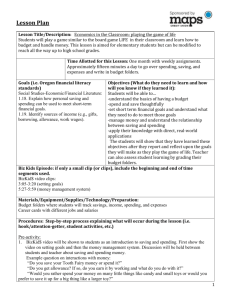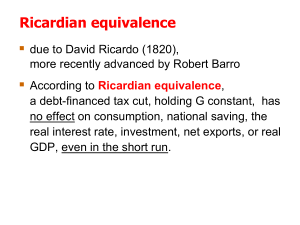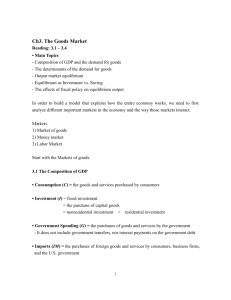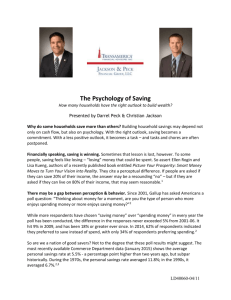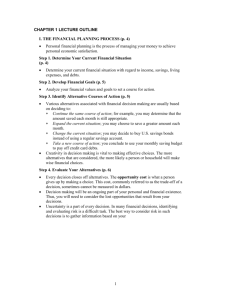Economics 154a, Spring 2005 Intermediate Macroeconomics
advertisement
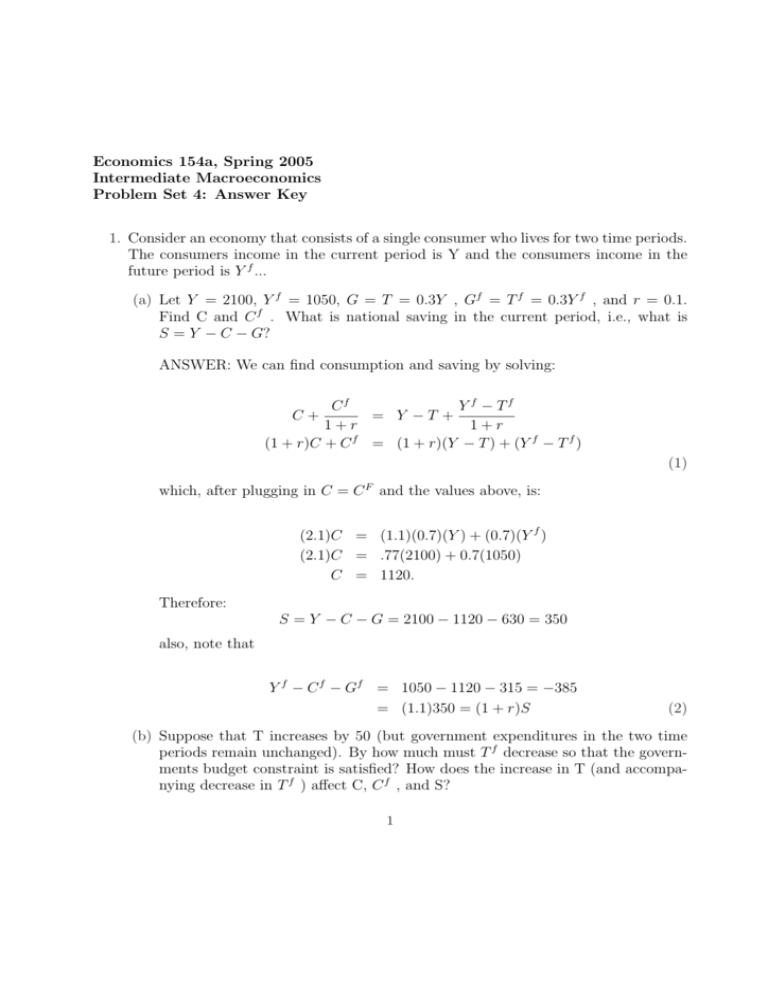
Economics 154a, Spring 2005 Intermediate Macroeconomics Problem Set 4: Answer Key 1. Consider an economy that consists of a single consumer who lives for two time periods. The consumers income in the current period is Y and the consumers income in the future period is Y f ... (a) Let Y = 2100, Y f = 1050, G = T = 0.3Y , Gf = T f = 0.3Y f , and r = 0.1. Find C and C f . What is national saving in the current period, i.e., what is S = Y − C − G? ANSWER: We can find consumption and saving by solving: Cf Y f − Tf = Y −T + 1+r 1+r (1 + r)C + C f = (1 + r)(Y − T ) + (Y f − T f ) C+ (1) which, after plugging in C = C F and the values above, is: (2.1)C = (1.1)(0.7)(Y ) + (0.7)(Y f ) (2.1)C = .77(2100) + 0.7(1050) C = 1120. Therefore: S = Y − C − G = 2100 − 1120 − 630 = 350 also, note that Y f − C f − Gf = 1050 − 1120 − 315 = −385 = (1.1)350 = (1 + r)S (2) (b) Suppose that T increases by 50 (but government expenditures in the two time periods remain unchanged). By how much must T f decrease so that the governments budget constraint is satisfied? How does the increase in T (and accompanying decrease in T f ) affect C, C f , and S? 1 ANSWER: The rate at which money can be passed on from one period to the next is 1+r. From the government’s inter-temporal budget constraint in particular we f can see that ∆T + ∆T = 0 which implies that ∆T f = −1.1∆T = 55. The agent’s 1.1 budget constraint doesn’t change at all, since the changes in taxes cancel out: à Cf Yf T f + ∆T f C+ = Y + − T + ∆T + 1+r 1+r 1+r à ! f f Y T = Y + − T+ 1+r 1+r ! Therefore consumption does not change, and since government consumption doesn’t change either, savings are also unchanged. (c) Suppose instead that there is a temporary increase in government spending: G increases by 50 but Gf remains unchanged. At the same time, T increases by 50, so that the governments budget constraint is still satisfied. How does the increase in G (and accompanying increase in T) affect C, C f , and S? ANSWER:Intuitively, with the change from T = 630 to T̂ = 680 the consumer will be $50 poorer the first period than he used to be, but he still wants to equalize consumption in both periods, so he’ll spread the loss across periods. Since private consumption does not fall as much as government spending increases, national saving decreases in the first period. Since consumption decreases in the second period, then savings increases. Analytically: (1 + r)C + C f = = (2.1)C = (2.1)C = C = (1 + r)(Y − T̂ ) + (Y f − T f ) (1 + r)(Y − T − 50) + (Y f − T f ) (1.1)(0.7Y − 50) + (0.7)(Y f ) 1.1(1470 − 50) + 0.7(1050) 1093.80 Then savings are: S = Y − C − G = 2100 − 1093.80 − 680 = 326.19 and note also that Y f − C f − Gf = 1050 − 1093.80 − 315 = −358.80 = (1 + r)326.19 2 (d) Suppose now that G increases by 50 but that the government finances this increase by increasing T f (keeping T constant at its original value). By how much must T f increase? How does the increase in G (and accompanying increase in T f ) affect C, C f , and S? ANSWER:Intuitively, the government is spending just as much as in (c), in present value, and therefore we’ll obtain the same results. Analytically: First we find the actual change in T f : ∆T f =0 1+r ∆T f = (1.1)∆G = 55 ∆G − (3) (4) (5) Then we get the new consumer budget constraint: (1 + r)C + C f = = (2.1)C = C = (1 + r)(Y − T ) + (Y f − Tˆf ) (1 + r)(Y − T ) + (Y f − T f − 55) 1.1(1470) + 0.7(1050) − 55 1093.80 Which is the same as in (c). Therefore we obtain S = 326.19 again. (e) Finally, suppose that the increase in government spending is permanent: both G and Gf increase by 50. In addition, assume that the government finances these increases by increasing both T and T f by 50. How do these changes affect C, C f , and S? ANSWER:Intuitively, the permanent change in G means a permanent change in income for the consumer, so there’s nothing to smooth out over time. Rather, consumption falls the exact amount that G increases. Analytically: The new consumer budget constraint is: (1 + r)C + C f = (1 + r)(Y − T̂ ) + (Y f − Tˆf ) = (1 + r)(Y − T − 50) + (Y f − T f − 50) 3 (2.1)C = 1.1(2100 − 630 − 50) + (1050 − 315 − 50) (2.1)C = 1.1(1420) + 685 C = 1070 Which is the original consumption less the new government spending. Savings is therefore just as in (a): S = 2100 − 1070 − 680 = 350. (f) In parts (b)(e), the interest rate r is held fixed at 10%. Your answers can, therefore, be viewed as determining how the desired national savings curve shifts in response to various changes in government spending and/or taxation. Holding government spending constant, how do changes in the timing of taxes shift the desired savings curve? Do temporary increases in government spending shift the desired savings curve by more or less than permanent increases in government spending? ANSWER: Since consumption does not respond to changes in the timing of taxes, (these agents are highly rational and forward-looking), saving increases in periods with less taxation and decreases in periods with more, as part (b) shows. National saving is unchanged however, as agents save all that the government does not save and vice-versa. Temporary increases in government spending shift result in smaller changes to our agent’s consumption, so that national saving decreases during periods of temporarily high government expenditures. Permanent expenditure increases however result in matching decreases of consumption, so that national saving is unaffected. (g) Which of the scenarios described in part (f)a shift in the timing of taxes, a temporary increase in government spending, or a permanent increase in government spendinghas the largest effect on equilibrium interest rates? (Hint: Answer this question using an investment-savings diagram like the one in Figure 4.6 on p. 140 of the textbook.) ANSWER: As figure 1 shows, only temporary changes in government spending have an effect on the interest rate. The savings curve changes leftwards by the size of the decrease in national savings. Since investment is negatively related to the interest rate, the equilibrium interest rate is higher. 2. Do numerical problem #2 from Chapter 7 on p. 272 in the textbook. ANSWER: 4 Sd (c),(d) r Id Sd (a),(b),(e) r1 r2 I,S Figure 1: Savings and Investment (a) M d = 100, 000 − 50, 000 − [5000(i − im )100]. (Multiplying by 100 is necessary since i and im are in decimals, not percent.) Simplifying this expression, we get M d = 50, 000 − 500, 000(i − im ). (b) B d = 50, 000+500, 000(i−im ). Adding these together we get M d +B d = 100, 000, which is Mr. Midas’s initial wealth. (c) This can be solved either by setting money supply equal to money demand, or by setting bond supply equal to bond demand and then by setting im = 0. M d = M s = 50, 000 − 500, 000(i − im ) = 20, 000 30, 000 = 500, 000i, so that i = 0.06 = 6%. Bd = Bs 50, 000 + 500, 000i = 80, 000 500, 000i = 30, 000, so that i = 0.06 = 6% again. 5 3. Do numerical problem #5 from Chapter 7 on p. 273 in the textbook. (Hint: If the nominal money supply is growing at a constant rate and is expected to continue growing at a constant rate, and if all markets are in equilibrium, then expected and actual inflation coincide.) ANSWERS (a) π e = ∆M/M = 10%. i = r + π e = 15%. M/P = L = 0.01(150/0.15) = 10. P = 300/10 = 30. (b) π e = ∆M/M = 5%. i = r + π e = 10%. M/P = L = 0.01(150/0.10) = 15. P = 300/15 = 20. NOTE to a high number of people getting this wrong in the problem set: The previous results, show that a decrease in the expected inflation rate (not a decrease in current prices!) results in an increased real DEMAND for money. Given a FIXED current nominal supply of money, this increased demand causes a decrease in the equilibrium prices, to bring up the real supply of money. Note that at no point in the current period does the amount of nominal money in the economy change! 4. Do analytical problem #4 from Chapter 7 on p. 273 in the textbook. Give careful explanations for each of your answers. (Hint: A temporary increase in labor supply shifts the labor supply curve out, or to the right. Because the increase is temporary rather than permanent, it affects current income but not future income.) ANSWERS (a) An increase in government purchases reduces national saving, causing the real interest rate to rise for a fixed level of income. If the real interest rate is higher, then real money demand will be lower. So prices must rise to make money supply equal money demand. The result is that output is unchanged, the real interest rate increases, and the price level increases. (b) When expected inflation falls, real money demand increases. With no effect on employment or saving and investment, output and the real interest rate remain unchanged. With higher real money demand and an unchanged nominal money supply, the equilibrium price level must decline. So output and the real interest rate are unchanged and prices decline. (c) When labor supply rises, full-employment output increases. Also, with higher output, saving will increase, so the real interest rate will decline. Both higher 6 output and a lower real interest rate increase real money demand. The price level must decline to equate money supply with money demand. The result is an increase in output and a decrease in both the real interest rate and the price level. (d) When the interest rate paid on money increases, real money demand rises. With no effect on employment or saving and investment, output and the real interest rate remain unchanged. With higher real money demand and an unchanged nominal money supply, the equilibrium price level must decline. So output and the real interest rate are unchanged and prices decline. NOTE: In the economy as discussed in class it is always the case that the labor market determines output, then the goods market determines rates and investment and saving, and finally the money market determines prices. It is never the case that a change in prices determines output or interest rates, or that a change in interest rates determines output! 7

